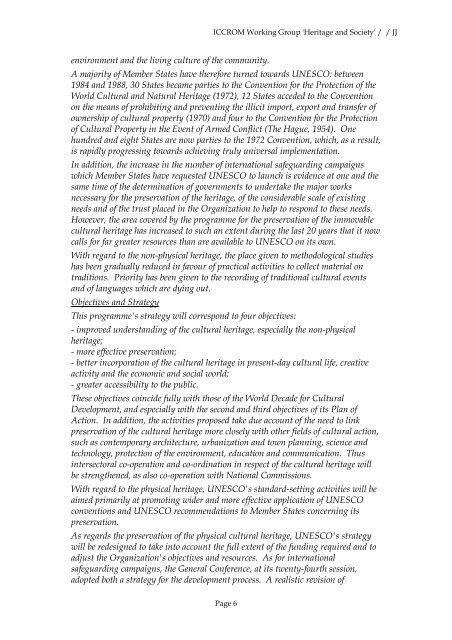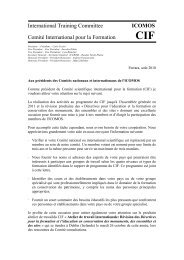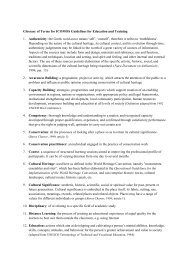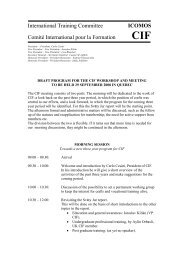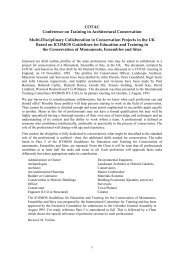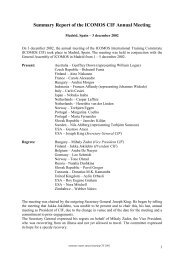Definition of Cultural Heritage -- References to ... - CIF - Icomos
Definition of Cultural Heritage -- References to ... - CIF - Icomos
Definition of Cultural Heritage -- References to ... - CIF - Icomos
Create successful ePaper yourself
Turn your PDF publications into a flip-book with our unique Google optimized e-Paper software.
environment and the living culture <strong>of</strong> the community.<br />
ICCROM Working Group '<strong>Heritage</strong> and Society' / / JJ<br />
A majority <strong>of</strong> Member States have therefore turned <strong>to</strong>wards UNESCO: between<br />
1984 and 1988, 30 States became parties <strong>to</strong> the Convention for the Protection <strong>of</strong> the<br />
World <strong>Cultural</strong> and Natural <strong>Heritage</strong> (1972), 12 States acceded <strong>to</strong> the Convention<br />
on the means <strong>of</strong> prohibiting and preventing the illicit import, export and transfer <strong>of</strong><br />
ownership <strong>of</strong> cultural property (1970) and four <strong>to</strong> the Convention for the Protection<br />
<strong>of</strong> <strong>Cultural</strong> Property in the Event <strong>of</strong> Armed Conflict (The Hague, 1954). One<br />
hundred and eight States are now parties <strong>to</strong> the 1972 Convention, which, as a result,<br />
is rapidly progressing <strong>to</strong>wards achieving truly universal implementation.<br />
In addition, the increase in the number <strong>of</strong> international safeguarding campaigns<br />
which Member States have requested UNESCO <strong>to</strong> launch is evidence at one and the<br />
same time <strong>of</strong> the determination <strong>of</strong> governments <strong>to</strong> undertake the major works<br />
necessary for the preservation <strong>of</strong> the heritage, <strong>of</strong> the considerable scale <strong>of</strong> existing<br />
needs and <strong>of</strong> the trust placed in the Organization <strong>to</strong> help <strong>to</strong> respond <strong>to</strong> these needs.<br />
However, the area covered by the programme for the preservation <strong>of</strong> the immovable<br />
cultural heritage has increased <strong>to</strong> such an extent during the last 20 years that it now<br />
calls for far greater resources than are available <strong>to</strong> UNESCO on its own.<br />
With regard <strong>to</strong> the non-physical heritage, the place given <strong>to</strong> methodological studies<br />
has been gradually reduced in favour <strong>of</strong> practical activities <strong>to</strong> collect material on<br />
traditions. Priority has been given <strong>to</strong> the recording <strong>of</strong> traditional cultural events<br />
and <strong>of</strong> languages which are dying out.<br />
Objectives and Strategy<br />
This programme's strategy will correspond <strong>to</strong> four objectives:<br />
- improved understanding <strong>of</strong> the cultural heritage, especially the non-physical<br />
heritage;<br />
- more effective preservation;<br />
- better incorporation <strong>of</strong> the cultural heritage in present-day cultural life, creative<br />
activity and the economic and social world;<br />
- greater accessibility <strong>to</strong> the public.<br />
These objectives coincide fully with those <strong>of</strong> the World Decade for <strong>Cultural</strong><br />
Development, and especially with the second and third objectives <strong>of</strong> its Plan <strong>of</strong><br />
Action. In addition, the activities proposed take due account <strong>of</strong> the need <strong>to</strong> link<br />
preservation <strong>of</strong> the cultural heritage more closely with other fields <strong>of</strong> cultural action,<br />
such as contemporary architecture, urbanization and <strong>to</strong>wn planning, science and<br />
technology, protection <strong>of</strong> the environment, education and communication. Thus<br />
intersec<strong>to</strong>ral co-operation and co-ordination in respect <strong>of</strong> the cultural heritage will<br />
be strengthened, as also co-operation with National Commissions.<br />
With regard <strong>to</strong> the physical heritage, UNESCO's standard-setting activities will be<br />
aimed primarily at promoting wider and more effective application <strong>of</strong> UNESCO<br />
conventions and UNESCO recommendations <strong>to</strong> Member States concerning its<br />
preservation.<br />
As regards the preservation <strong>of</strong> the physical cultural heritage, UNESCO's strategy<br />
will be redesigned <strong>to</strong> take in<strong>to</strong> account the full extent <strong>of</strong> the funding required and <strong>to</strong><br />
adjust the Organization's objectives and resources. As for international<br />
safeguarding campaigns, the General Conference, at its twenty-fourth session,<br />
adopted both a strategy for the development process. A realistic revision <strong>of</strong><br />
Page 6


